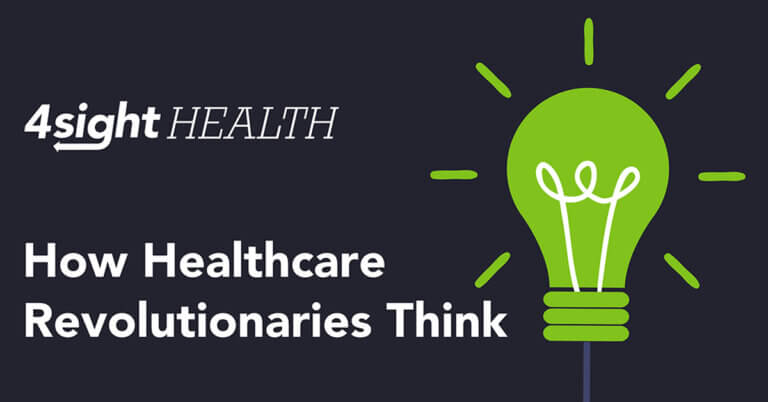September 24, 2020

Avoid Becoming an IT Dinosaur
Please welcome Ed Marx as 4sight Health’s newest guest columnist. Ed is among the nation’s most respected health IT leaders and an accomplished Iron Man competitor. As you’ll see in his initial article, he’s willing to go the distance in advancing healthcare IT’s capacity to delight both clinicians and consumers as well as deliver superior outcomes. Ed doesn’t mince words, writes with passion and believes IT teams must lead their organizations to the promised land of revolutionary healthcare. I’ll jump the barricades with Ed anytime. – Dave Johnson, CEO of 4sight Health
My military combat training took place during the early ’90s. As a young combat engineer officer, I trained in the art of mobility, countermobility, survivability and engineering. Battle scenarios focused on large scale ground wars, likely in northern Europe. Thankfully, combat between the then Soviet Union and US never materialized.
New enemies required new tactics. It took a generation to reconfigure battle doctrines to combat the asynchronous enemies the U.S. military confronts today. Small teams. Counterinsurgency capabilities. Specialized operations. Cyber campaigns. Information superiority and technology innovation are the bedrocks of today’s postmodern military.
Like the 1990s U.S. military, the current health system IT doctrine supports large, centralized operations (e.g. hospitals). Buoyed by the previous generation of health record stimulus investments, we built massive technology departments. Many hospitals have self-sustaining technology capabilities replete with giant data centers, cybersecurity operation centers, network operations centers and application development capabilities. They staff 24/7 service desks for each center. As my military service was largely confined to the Reserves, I observed this phenomena simultaneous to my growing healthcare career. What I learned from one I would apply to the other.
IT growth and investment outpaced revenue and caught the eye of the healthcare CEO and CFO. When more was expected, we always did more with…more. Application sprawl, technical debt, aged infrastructure and undisciplined growth spiraled out of control. We answered by adding more FTE. That model is unsustainable. Especially today.
Like the 1990s U.S. military, healthcare technology teams confront a dynamic operating environment. Current practices lack the capabilities and flexibility required to succeed in a more competitive, consumer-oriented marketplace. Health systems need an updated IT doctrine.
Still not convinced healthcare IT is a generation behind? See how you answer these questions and observations.
- How many IT leaders obsess over benchmarking to peer performance levels? In a disruptive period, that’s ludicrous. Other health systems are in the same situation as your health system. I recommend benchmarking against industries that have already digitally transformed, particularly against leaders in those industries. At the Cleveland Clinic, when we benchmarked our analytics to healthcare systems, we were top five in the country. When we benchmarked to other industries, healthcare as an industry was near the bottom.
- How many times have you accepted and dutifully implemented across-the-board budget cuts? I did for most of my career. Postmodern healthcare IT leaders never find themselves in this situation. They already run lean and return budget back to the organization without asking.
- Why does healthcare hire CIO/CDO from outside of healthcare? That answer is obvious. They’ve already lived healthcare’s future.
- Health systems lag years behind other industries on simple transformation initiatives such as implementing cloud-based services or written digital strategies. Why is it so hard to change directions? We can’t wait too long to transform or the marketplace will dictate our terms of engagement?
Hopefully, I’ve got your attention now. Postmodern healthcare IT can learn from the U.S. military’s transformation. Team-of-teams organizational structures have replaced command and control hierarchies. Small teams of specialists have replaced large inefficient units. The military contracts with specialized firms for noncombat functions not directly related to mission.
In today’s military, the measure of success is not the number of brigades and battalions, it’s outcomes. With notable exceptions, today’s healthcare IT divisions are fighting the last war. They are not positioned to facilitate the repositioning and financial survival of their organizations.
Consider the following five traits of postmodern healthcare IT. How many does your organization have? IT executives must be proactive and execute ahead of the curve. It’s become “survival of the digitalist.” Here’s what you have to do.
‣ Drive Agility.
You cannot deliver on the promise of digital transformation with traditional IT. Period. You must embrace agility. The entire IT division must become agile, not just application development or project management. Transformation requires a new culture, mindset and a complete restructuring of workflows. Traditional IT is the opposite of agile. The IT function requires fundamental change. Train, test and certify all IT staff for the new agile practice and mindset. Those that refuse to get with the program need to get out.
‣ Embrace Best Practices.
You cannot run IT the same way as previous generations and expect different results, but that’s how it’s done in most hospitals. You need to adopt best practices, like clinical leaders do. Pursuing best practices is the primary method for ensuring high quality services.
IT Service Management (ITSM) is the most widely accepted best practice. ITSM provides a time-tested framework and vocabulary for operations. ITSM measures and communicates transparent results. All IT FTEs must become ITSM certified as a condition of employment. You would not trust an uncertified clinician with your medical treatment. Why should peers, clinicians and patients trust you?
‣ Act Strategically.
Agile IT creates strategic differentiation. Operations is a commodity. Health systems should outsource all non-strategic IT functions. Everything. Plain and simple. Post-modern IT supports the hospital’s overall strategy and adjusts in relationship to strategic changes. IT is no longer a black hole where money and time disappear. At its most effective, IT is transparent vessel where its decision-making, investments and performance are visible to all.
‣ Focus on Experiences.
IT should center on the experiences of caregivers, patients and families. IT becomes less technology-focused when it improves experiences of everyone in the ecosystem. Outsource commodity IT to companies who perform this work cheaper and better. Build diverse in-house IT teams to service specific customer segments with related products and services. Rotate assignments and embed teams deep within their customer segments. Make sure teams include diverse individuals, clinicians and customer experience professionals from outside of healthcare.
‣ Live Lean.
IT is best when comprised of small, nimble and self-directed teams. Retain teams core to healthcare and the customer experience. Everything else is a commodity. Cybersecurity is a commodity. Application support. Yep. Service desks. Yep. Field services. Yep. Data centers… Done well, you can eliminate 20-40% of operational costs through outsourcing. Negotiate to retain half the savings to reinvest in digital transformation. Execute well and show results.
Post-modern military tactics reversed the tide in Iraq by empowering frontline troops. IT plays an essential role in supporting transparent information flow and improving real-time decision making. Healthcare IT has the same potential to transform and improve hospital operations.
Post-modern healthcare IT is not simply a cost center. It is the key to healthcare digital transformation. No hospital is capable of significant transformation without a modernized IT function leading the way into healthcare’s brave new, customer-centric future.
Interested in how the team-of-teams concept can help hospital IT operations? Read a related Market Corner Commentary here.
Want to know what healthcare executives are talking about this week? Subscribe to the 4sight Friday RoundUp on iTunes, Spotify, or where ever you listen to podcasts.





